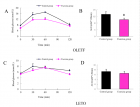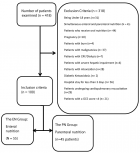Abstract
Review Article
Premature ovarian insufficiency in children: Etiology, clinical management and treatment
Chunlin Wang* and Ke Yuan
Published: 19 November, 2020 | Volume 3 - Issue 1 | Pages: 047-055
Premature ovarian insufficiency (POI) is a rare disease, especially in children and adolescents. It was previously called premature ovarian failure (POF). It can be manifested as delayed puberty, primary or secondary amenorrhea that occurred before the age of 40 years with no less than two abnormal serum sex hormones (low estrogen and high gonadotropin). It is reported that the incidence rate is 1% at the age of 40 years and 0.01% at the age of 20 years. Although the disease usually occurs in middle-aged and elderly women, clinical practice in recent years has shown that it has also been found in adolescents and even children. It is generally believed that the etiology of POI includes genetic factors, immune factors, and iatrogenic factors. So far, several genetic mutations that may cause POI have been found clinically, but the etiology of 90% of POI is still unknown. In recent years, the incidence of POI in children and adolescents has increased, and there are more urgent requirements for its early diagnosis, treatment, and clinical management. Based on this, this article will mainly review the research progress of the etiology, treatment, and clinical management of POI in children and adolescents.
Read Full Article HTML DOI: 10.29328/journal.japch.1001017 Cite this Article Read Full Article PDF
Keywords:
Children; Premature ovarian insufficiency; Etiology; Hormone replacement therapy; Clinical management
References
- Goswami D, Conway GS. Premature ovarian failure. Horm Res. 2007: 68: 196-202. PubMed: https://pubmed.ncbi.nlm.nih.gov/17495481/
- Webber L, Davies M, Anderson R, Bartlett J, Braat D, et al. ESHRE Guideline: management of women with premature ovarian insufficiency. Hum Reprod. 2016; 31: 926-397. PubMed: https://pubmed.ncbi.nlm.nih.gov/27008889/
- Vujovic S, Ivović M, Tancić-Gajić M, Marina L, Barać M, et al. Premature ovarian failure. Srp Arh Celok Lek. 2012; 140: 806-811. PubMed: https://pubmed.ncbi.nlm.nih.gov/23350261/
- Tao XY, Zuo AZ, Wang JQ, Tao FB. Effect of primary ovarian insufficiency and early natural menopause on mortality: a meta-analysis. Climacteric. 2016; 19: 27-36. PubMed: https://pubmed.ncbi.nlm.nih.gov/26576012/
- Tsiligiannis S, Panay N, Stevenson JC. Premature Ovarian Insufficiency and Long-Term Health Consequences. Curr Vasc Pharmacol. 2019; 17: 604-609. PubMed: https://pubmed.ncbi.nlm.nih.gov/30819073/
- Laissue P. Aetiological coding sequence variants in non-syndromic premature ovarian failure: From genetic linkage analysis to next generation sequencing. Mol Cell Endocrinol. 2015; 411: 243-257. PubMed: https://pubmed.ncbi.nlm.nih.gov/25960166/
- Ferreira SI, Matoso E, Pinto M, Almeida J, Liehr T, et al. X-chromosome terminal deletion in a female with premature ovarian failure: Haploinsufficiency of X-linked genes as a possible explanation. Mol Cytogenet. 2010; 3: 14. PubMed: https://pubmed.ncbi.nlm.nih.gov/20646274/
- Hook EB, Warburton D. Turner syndrome revisited: review of new data supports the hypothesis that all viable 45,X cases are cryptic mosaics with a rescue cell line, implying an origin by mitotic loss. Hum Genet. 2014; 133: 417-424. PubMed: https://pubmed.ncbi.nlm.nih.gov/24477775/
- Modi D, Sane S, Bhartiya D. Over-expression of Mullerian inhibiting substance mRNA in the Turner syndrome ovary. Sex Dev. 2009; 3: 245-252. PubMed: https://pubmed.ncbi.nlm.nih.gov/19940443/
- Karnis MF. Catastrophic consequences of assisted reproduction: the case of Turner syndrome. Semin Reprod Med. 2012; 30: 116-122. PubMed: https://pubmed.ncbi.nlm.nih.gov/22549711/
- Simpson JL, Rajkovic A. Ovarian differentiation and gonadal failure. Am J Med Genet. 1999; 89: 186-200. PubMed: https://pubmed.ncbi.nlm.nih.gov/10727994/
- Kara C, Üstyol A, Yılmaz A, Altundağ E, Oğur G. Premature ovarian failure due to tetrasomy X in an adolescent girl. Eur J Pediatr. 2014; 173: 1627-1630.
- Sugawara, N, Maeda M, Manome T, Nagai R, Araki Y. Patients with 47, XXX karyotype who experienced premature ovarian failure (POF): two case reports. Reprod Med Biol. 2013; 12: 193-195. PubMed: https://www.ncbi.nlm.nih.gov/pmc/articles/PMC5906948/
- Wood A, Kleis L, Toriello H, Cemeroglu AP. Mosaic pentasomy X/tetrasomy X syndrome and premature ovarian failure. Indian Pediatr. 2011; 48: 402-404. PubMed: https://pubmed.ncbi.nlm.nih.gov/21654007/
- Therman E, Laxova R, Susman B. The critical region on the human Xq. Hum Genet. 1990; 85: 455-461. PubMed: https://pubmed.ncbi.nlm.nih.gov/2227929/
- Conway GS. Premature ovarian failure and FMR1 gene mutations: an update. Ann Endocrinol (Paris). 2010; 71: 215-217. PubMed: https://pubmed.ncbi.nlm.nih.gov/20398889/
- Bouali, N, Hmida D, Mougou S, Bouligand J, Lakhal B, et al. Analysis of FMR1 gene premutation and X chromosome cytogenetic abnormalities in 100 Tunisian patients presenting premature ovarian failure. Ann Endocrinol (Paris). 2015; 76: 671-678. PubMed: https://pubmed.ncbi.nlm.nih.gov/26593861/
- Pastore LM, Johnson J. The FMR1 gene, infertility, and reproductive decision-making: a review. Front Genet. 2014; 5: 195. PubMed: https://pubmed.ncbi.nlm.nih.gov/25071825/
- Yang XW, He W, Gong F, Li W, Li X, et al. Novel FOXL2 mutations cause blepharophimosis-ptosis-epicanthus inversus syndrome with premature ovarian insufficiency. Mol Genet Genomic Med. 2018; 6: 261-267. PubMed: https://pubmed.ncbi.nlm.nih.gov/29378385/
- Chen B, Li L, Wang J, Li T, Pan H, et al. Consanguineous familial study revealed biallelic FIGLA mutation associated with premature ovarian insufficiency. J Ovarian Res. 2018; 11: 48. PubMed: https://pubmed.ncbi.nlm.nih.gov/29914564/
- Franic-Ivanisevic M, Franić D, Ivović M, Tančić-Gajić M, Marina L, et al. Genetic Etiology of Primary Premature Ovarian Insufficiency. Acta Clin Croat. 2016; 55: 629-635. PubMed: https://pubmed.ncbi.nlm.nih.gov/29117655/
- Jaillard S, Tucker SJ, Akloul L, Beaumont M, Domin M, et al. 22q11.2 rearrangements found in women with low ovarian reserve and premature ovarian insufficiency. J Hum Genet. 2018; 63: 691-698. PubMed: https://pubmed.ncbi.nlm.nih.gov/29540854/
- Wang Q, Li D, Cai B, Chen Q, Li C, et al. Whole-exome sequencing reveals SALL4 variants in premature ovarian insufficiency: an update on genotype-phenotype correlations. Hum Genet. 2019; 138: 83-92. PubMed: https://pubmed.ncbi.nlm.nih.gov/30603774/
- Tucker EJ, Grover SR, Bachelot A, Touraine P, Sinclair AH. Premature Ovarian Insufficiency: New Perspectives on Genetic Cause and Phenotypic Spectrum. Endocr Rev. 2016; 37: 609-635. PubMed: https://pubmed.ncbi.nlm.nih.gov/27690531/
- Lin L, Achermann JC. Steroidogenic factor-1 (SF-1, Ad4BP, NR5A1) and disorders of testis development. Sex Dev. 2008; 2: 200-209. PubMed: https://pubmed.ncbi.nlm.nih.gov/18987494/
- Brauner R, Pierrepont S, Bignon-Topalovic J, McElreavey K, Bashamboo A. Etiology of primary ovarian insufficiency in a series young girls presenting at a pediatric endocrinology center. Eur J Pediatr. 2015; 174: 767-773. PubMed: https://pubmed.ncbi.nlm.nih.gov/25425520/
- Irusta G, Pazos MC, Abramovich D, De Zúñiga I, Parborell F, et al. Effects of an inhibitor of the gamma-secretase complex on proliferation and apoptotic parameters in a FOXL2-mutated granulosa tumor cell line (KGN). Biol Reprod. 2013; 89: 9. PubMed: https://pubmed.ncbi.nlm.nih.gov/23699387/
- Li Y, Schang G, Wang Y, Zhou X, Levasseur A, et al. Conditional Deletion of FOXL2 and SMAD4 in Gonadotropes of Adult Mice Causes Isolated FSH Deficiency. Endocrinology. 2018; 159: 2641-2655. PubMed: https://pubmed.ncbi.nlm.nih.gov/29800110/
- Martinez-Juarez A, López-Luna MA, Porras-Gómez TJ, Moreno-Mendoza N. Expression of the Sox9, Foxl2, Vasa, and TRPV4 genes in the ovaries and testes of the Morelet's crocodile, Crocodylus moreletii. J Exp Zool B Mol Dev Evol. 2018; 330: 148-164. PubMed: https://pubmed.ncbi.nlm.nih.gov/29602213/
- Tang B, Zhang Y, Zhang W, Zhu Y, Yuan S. Deletion of FOXL2 by CRISPR promotes cell cycle G0/G1 restriction in KGN cells. Int J Mol Med. 2019; 43: 567-574. PubMed: https://pubmed.ncbi.nlm.nih.gov/30365048/
- Stange K, Désir J, Kakar N, Mueller TD, Budde BS, et al. A hypomorphic BMPR1B mutation causes du Pan acromesomelic dysplasia. Orphanet J Rare Dis. 2015; 10: 84. PubMed: https://pubmed.ncbi.nlm.nih.gov/26105076/
- Caburet S, Arboleda VA, Llano E, Overbeek PA, Barbero JS, et al. Mutant cohesin in premature ovarian failure. N Engl J Med. 2014; 370: 943-949. PubMed: https://pubmed.ncbi.nlm.nih.gov/24597867/
- Faridi R, Rehman AU, Morell RJ, Friedman PL, Demain L, et al. Mutations of SGO2 and CLDN14 collectively cause coincidental Perrault syndrome. Clin Genet. 2017; 91: 328-332. PubMed: https://pubmed.ncbi.nlm.nih.gov/27629923/
- Lacombe A, Lee H, Zahed L, Choucair M, Muller J, et al. Disruption of POF1B binding to nonmuscle actin filaments is associated with premature ovarian failure. Am J Hum Genet. 2006; 79: 113-119. PubMed: https://www.ncbi.nlm.nih.gov/pmc/articles/PMC1474115/
- de Vries FA, de Boer E, van den Bosch M, Baarends WM, Ooms M, et al. Mouse Sycp1 functions in synaptonemal complex assembly, meiotic recombination, and XY body formation. Genes Dev. 2005; 19: 1376-1389. PubMed: https://pubmed.ncbi.nlm.nih.gov/15937223/
- Al-Agha AE, Ahmed IA, Nuebel E, Moriwaki M, Moore B, et al. Primary Ovarian Insufficiency and Azoospermia in Carriers of a Homozygous PSMC3IP Stop Gain Mutation. J Clin Endocrinol Metab. 2018; 103: 555-563. PubMed: https://pubmed.ncbi.nlm.nih.gov/29240891/
- Zhang YX, Li H, He W, Tu C, Du J, et al. XRCC2 mutation causes premature ovarian insufficiency as well as nonobstructive azoospermia in humans. Clin Genet. 2019; 95: 442-443. PubMed: https://pubmed.ncbi.nlm.nih.gov/30489636/
- De Bellis A, Bellastella G, Falorni A, Aitella E, Barrasso M, et al. Natural history of autoimmune primary ovarian insufficiency in patients with Addison's disease: from normal ovarian function to overt ovarian dysfunction. Eur J Endocrinol. 2017; 177: 329-337. PubMed: https://pubmed.ncbi.nlm.nih.gov/28733292/
- AlAsiri S, Basit S, Wood-Trageser MA, Yatsenko SA, Jeffries EP, et al. Exome sequencing reveals MCM8 mutation underlies ovarian failure and chromosomal instability. J Clin Invest. 2015; 125: 258-262. PubMed: https://pubmed.ncbi.nlm.nih.gov/25437880/
- Goldberg Y, Halpern N, Hubert A, Adler SN, Cohen S, et al. Mutated MCM9 is associated with predisposition to hereditary mixed polyposis and colorectal cancer in addition to primary ovarian failure. Cancer Genet. 2015; 208: 621-624. PubMed: https://pubmed.ncbi.nlm.nih.gov/26806154/
- Qin Y, Guo T, Li G, Tang T, Zhao S, et al. CSB-PGBD3 Mutations Cause Premature Ovarian Failure. PLoS Genet. 2015; 11: e1005419. PubMed: https://pubmed.ncbi.nlm.nih.gov/26218421/
- Kasippillai T, MacArthur DG, Kirby A, Thomas B, Lambalk CB, et al. Mutations in eIF4ENIF1 are associated with primary ovarian insufficiency. J Clin Endocrinol Metab. 2013; 98: E1534-1539. PubMed: https://pubmed.ncbi.nlm.nih.gov/23902945/
- Persani L, Rossetti R, Di Pasquale E, Cacciatore C, Fabre S. The fundamental role of bone morphogenetic protein 15 in ovarian function and its involvement in female fertility disorders. Hum Reprod Update. 2014; 20: 869-883. PubMed: https://pubmed.ncbi.nlm.nih.gov/24980253/
- Regan S, Knight PG, Yovich JL, Leung Y, Arfuso F, et al. Involvement of Bone Morphogenetic Proteins (BMP) in the Regulation of Ovarian Function. Vitam Horm. 2018; 107: 227-261. PubMed: https://pubmed.ncbi.nlm.nih.gov/29544632/
- Belli M, Shimasaki S. Molecular Aspects and Clinical Relevance of GDF9 and BMP15 in Ovarian Function. Vitam Horm. 2018; 107: 317-348. PubMed: https://pubmed.ncbi.nlm.nih.gov/29544636/
- Qin Y, Shi Y, Zhao Y, Carson SA, Simpson JL, et al. Mutation analysis of NOBOX homeodomain in Chinese women with premature ovarian failure. Fertil Steril. 2009; 91(4 Suppl): 1507-1509. PubMed: https://pubmed.ncbi.nlm.nih.gov/18930203/
- Kuechler A, Hauffa BP, Köninger A, Kleinau G, Albrecht B, et al. An unbalanced translocation unmasks a recessive mutation in the follicle-stimulating hormone receptor (FSHR) gene and causes FSH resistance. Eur J Hum Genet. 2010; 18: 656-661. PubMed: https://pubmed.ncbi.nlm.nih.gov/20087398/
- Simsek E, Ozdemir I, Lin L, Achermann JC. Isolated 17,20-lyase (desmolase) deficiency in a 46,XX female presenting with delayed puberty. Fertil Steril. 2005; 83: 1548-1551. PubMed: https://pubmed.ncbi.nlm.nih.gov/15866602/
- Pagnamenta AT, Taanman J, Wilson CJ, Anderson NE, Marotta R, et al. Dominant inheritance of premature ovarian failure associated with mutant mitochondrial DNA polymerase gamma. Hum Reprod. 2006; 21: 2467-2473. PubMed: https://pubmed.ncbi.nlm.nih.gov/16595552/
- Hornig-Do HT, Montanari A, Rozanska A, Tuppen HA, Almalki AA, et al. Human mitochondrial leucyl tRNA synthetase can suppress non cognate pathogenic mt-tRNA mutations. EMBO Mol Med. 2014; 6: 183-193. PubMed: https://pubmed.ncbi.nlm.nih.gov/24413189/
- Pierce SB, Gersak K, Michaelson-Cohen R, Walsh T, Lee MK, et al. Mutations in LARS2, encoding mitochondrial leucyl-tRNA synthetase, lead to premature ovarian failure and hearing loss in Perrault syndrome. Am J Hum Genet. 2013; 92: 614-620. PubMed: https://pubmed.ncbi.nlm.nih.gov/23541342/
- Dallabona C, Diodato D, Kevelam SH, Haack TB, Wong LJ, et al. Novel (ovario) leukodystrophy related to AARS2 mutations. Neurology. 2014; 82: 2063-2071. PubMed: https://pubmed.ncbi.nlm.nih.gov/24808023/
- Little DT, Ward HR. Adolescent Premature Ovarian Insufficiency Following Human Papillomavirus Vaccination: A Case Series Seen in General Practice. J Investig Med High Impact Case Rep. 2014; 2: 2324709614556129. PubMed: https://pubmed.ncbi.nlm.nih.gov/26425627/
- Akawatcharangura P, Taechakraichana N, Osiri M. Prevalence of premature ovarian failure in systemic lupus erythematosus patients treated with immunosuppressive agents in Thailand. Lupus. 2016; 25: 436-444. PubMed: https://pubmed.ncbi.nlm.nih.gov/26621134/
- Vabre P, Gatimel N, Moreau J, Gayrard V, Picard-Hagen N, et al. Environmental pollutants, a possible etiology for premature ovarian insufficiency: a narrative review of animal and human data. Environ Health. 2017; 16: 37. PubMed: https://pubmed.ncbi.nlm.nih.gov/28388912/
- Torrealday S, Kodaman, Pal L. Premature Ovarian Insufficiency - an update on recent advances in understanding and management. F1000 Res. 2017; 6: 2069. PubMed: https://www.ncbi.nlm.nih.gov/pmc/articles/PMC5710309/
- Fenton AJ. Premature ovarian insufficiency: Pathogenesis and management. J Midlife Health. 2015; 6: 147-153. PubMed: https://www.ncbi.nlm.nih.gov/pmc/articles/PMC4743275/
- Hodis HN, Mack WJ, Henderson VW, Shoupe M, Budoff MJ, et al. Vascular Effects of Early versus Late Postmenopausal Treatment with Estradiol. N Engl J Med. 2016; 374: 1221-1231. PubMed: https://www.ncbi.nlm.nih.gov/pmc/articles/PMC4921205/
- Mohammed K, Dabrh AMA, Benkhadra K, Al Nofal A, Leon BGC, et al. Oral vs Transdermal Estrogen Therapy and Vascular Events: A Systematic Review and Meta-Analysis. J Clin Endocrinol Metab. 2015; 100: 4012-4020. PubMed: https://pubmed.ncbi.nlm.nih.gov/26544651/
- Ge W, Li L, Dyce PW, De Felici M, Shen W. Establishment and depletion of the ovarian reserve: physiology and impact of environmental chemicals. Cell Mol Life Sci. 2019; 76: 1729-1746. PubMed: https://pubmed.ncbi.nlm.nih.gov/30810760/
- Vujovic S, Brincat M, Erel T, Gambacciani M, Lambrinoudaki I, et al. EMAS position statement: Managing women with premature ovarian failure. Maturitas. 2010; 67: 91-93. PubMed: https://pubmed.ncbi.nlm.nih.gov/20605383/
- Popat VB, Calis KA, Vanderhoof VH, Cizza G, Reynolds JC, et al. Bone mineral density in estrogen-deficient young women. J Clin Endocrinol Metab, 2009. 94: 2277-2283. PubMed: https://pubmed.ncbi.nlm.nih.gov/19401379/
- Schmidt J, Cardoso GMP, Ross JL, Haq N, Rubinow DR, et al. Shyness, social anxiety, and impaired self-esteem in Turner syndrome and premature ovarian failure. JAMA. 2006; 295: 1374-1376. PubMed: https://pubmed.ncbi.nlm.nih.gov/16551707/
Figures:

Figure 1
Similar Articles
-
Congenital poisoning after maternal parenteral mercury administrationBenjamin Courchia*,Leventer Roberts Maya,Meyer John,Galvez Maida,Herrera Jaime,Rauch Daniel. Congenital poisoning after maternal parenteral mercury administration. . 2018 doi: 10.29328/journal.japch.1001001; 1: 001-005
-
The Impact of Adenotonsillectomy on Health-Related Quality of Life in Paediatric PatientsShuaib Kayode Aremu*. The Impact of Adenotonsillectomy on Health-Related Quality of Life in Paediatric Patients. . 2018 doi: 10.29328/journal.japch.1001002; 1: 006-011
-
Prevalence of ESBL urinary tract infection in childrenKhalil Salameh*,Galia ZA Awean,Hala Elmohamed,Hoor Alshmayt,Mohamed Riad Bur Omer . Prevalence of ESBL urinary tract infection in children. . 2019 doi: 10.29328/journal.japch.1001004; 2: 004-007
-
Aripiprazole-induced seizures in children with autism spectrum disorder and epilepsyMohammed MS Jan*. Aripiprazole-induced seizures in children with autism spectrum disorder and epilepsy. . 2020 doi: 10.29328/journal.japch.1001009; 3: 008-010
-
So-called idiopathic scoliosis – disfiguring deformity in children, pain problems in adults. Information about biomechanical etiology, classification and therapyTomasz Karski*. So-called idiopathic scoliosis – disfiguring deformity in children, pain problems in adults. Information about biomechanical etiology, classification and therapy. . 2020 doi: 10.29328/journal.japch.1001011; 3: 016-020
-
“Syndrome of Contractures and Deformities” according Prof. Hans Mau. Symptoms, diagnosis, treatment: Recommendations for parentsTomasz Karski*,Jacek Karski. “Syndrome of Contractures and Deformities” according Prof. Hans Mau. Symptoms, diagnosis, treatment: Recommendations for parents. . 2020 doi: 10.29328/journal.japch.1001012; 3: 021-023
-
The practice of self-medication in children by their mothers in Lubumbashi, Democratic Republic of CongoOlivier Mukuku*,Astrid Mukemo Katumbo,Thierry Sonny Tshiningi,Judith Sangwa Sinanduku,Loriot Kayinga Mudisu,Peggy Mulunda Mwadi,Oscar Numbi Luboya,Françoise Kaj Malonga. The practice of self-medication in children by their mothers in Lubumbashi, Democratic Republic of Congo. . 2020 doi: 10.29328/journal.japch.1001014; 3: 027-031
-
Premature ovarian insufficiency in children: Etiology, clinical management and treatmentChunlin Wang*,Ke Yuan. Premature ovarian insufficiency in children: Etiology, clinical management and treatment. . 2020 doi: 10.29328/journal.japch.1001017; 3: 047-055
-
A rare case report on pediatric shellfish allergyBetsy Mathew*,Ananta Jois. A rare case report on pediatric shellfish allergy. . 2020 doi: 10.29328/journal.japch.1001018; 3: 056-057
-
A girl with a stiff neckG Carlone*,A Prisco,F Vittoria,E Barbi,M Carbone. A girl with a stiff neck. . 2020 doi: 10.29328/journal.japch.1001019; 3: 058-060
Recently Viewed
-
Internet Addiction and its Relationship with Attachment Styles Among Tunisian Medical StudentsRim Masmoudi*, Ahmed Mhalla, Amjed Ben Haouala, Wael Majdoub, Jawaher Masmoudi, Badii Amamou, Lotfi Gaha. Internet Addiction and its Relationship with Attachment Styles Among Tunisian Medical Students. J Addict Ther Res. 2023: doi: 10.29328/journal.jatr.1001027; 7: 012-018
-
Differences between anorexia patients and participants of the Minnesota hunger experiment: Consequences for treatmentGreta Noordenbos*. Differences between anorexia patients and participants of the Minnesota hunger experiment: Consequences for treatment. J Addict Ther Res. 2021: doi: 10.29328/journal.jatr.1001013; 5: 001-002
-
Estimation of cotinine level among the tobacco users and nonusers: A cross-sectional study among the Indian populationSukhvinder Singh Oberoi*,Avneet Oberoi. Estimation of cotinine level among the tobacco users and nonusers: A cross-sectional study among the Indian population. J Addict Ther Res. 2021: doi: 10.29328/journal.jatr.1001014; 5: 003-008
-
Drug treatment and rehabilitation in China: Theoretical rationales and current situationsGloria Yuxuan Gu*. Drug treatment and rehabilitation in China: Theoretical rationales and current situations. J Addict Ther Res. 2021: doi: 10.29328/journal.jatr.1001015; 5: 009-011
-
Patterns of drugs and alcohol abuse among youthTamar Ruth Orowitz*. Patterns of drugs and alcohol abuse among youth. J Addict Ther Res. 2021: doi: 10.29328/journal.jatr.1001016; 5: 012-013
Most Viewed
-
Feasibility study of magnetic sensing for detecting single-neuron action potentialsDenis Tonini,Kai Wu,Renata Saha,Jian-Ping Wang*. Feasibility study of magnetic sensing for detecting single-neuron action potentials. Ann Biomed Sci Eng. 2022 doi: 10.29328/journal.abse.1001018; 6: 019-029
-
Evaluation of In vitro and Ex vivo Models for Studying the Effectiveness of Vaginal Drug Systems in Controlling Microbe Infections: A Systematic ReviewMohammad Hossein Karami*, Majid Abdouss*, Mandana Karami. Evaluation of In vitro and Ex vivo Models for Studying the Effectiveness of Vaginal Drug Systems in Controlling Microbe Infections: A Systematic Review. Clin J Obstet Gynecol. 2023 doi: 10.29328/journal.cjog.1001151; 6: 201-215
-
Causal Link between Human Blood Metabolites and Asthma: An Investigation Using Mendelian RandomizationYong-Qing Zhu, Xiao-Yan Meng, Jing-Hua Yang*. Causal Link between Human Blood Metabolites and Asthma: An Investigation Using Mendelian Randomization. Arch Asthma Allergy Immunol. 2023 doi: 10.29328/journal.aaai.1001032; 7: 012-022
-
Impact of Latex Sensitization on Asthma and Rhinitis Progression: A Study at Abidjan-Cocody University Hospital - Côte d’Ivoire (Progression of Asthma and Rhinitis related to Latex Sensitization)Dasse Sery Romuald*, KL Siransy, N Koffi, RO Yeboah, EK Nguessan, HA Adou, VP Goran-Kouacou, AU Assi, JY Seri, S Moussa, D Oura, CL Memel, H Koya, E Atoukoula. Impact of Latex Sensitization on Asthma and Rhinitis Progression: A Study at Abidjan-Cocody University Hospital - Côte d’Ivoire (Progression of Asthma and Rhinitis related to Latex Sensitization). Arch Asthma Allergy Immunol. 2024 doi: 10.29328/journal.aaai.1001035; 8: 007-012
-
An algorithm to safely manage oral food challenge in an office-based setting for children with multiple food allergiesNathalie Cottel,Aïcha Dieme,Véronique Orcel,Yannick Chantran,Mélisande Bourgoin-Heck,Jocelyne Just. An algorithm to safely manage oral food challenge in an office-based setting for children with multiple food allergies. Arch Asthma Allergy Immunol. 2021 doi: 10.29328/journal.aaai.1001027; 5: 030-037

If you are already a member of our network and need to keep track of any developments regarding a question you have already submitted, click "take me to my Query."

















































































































































